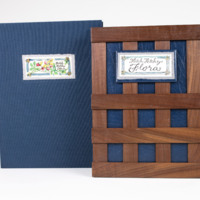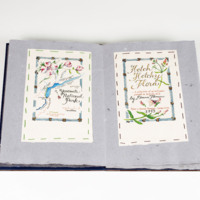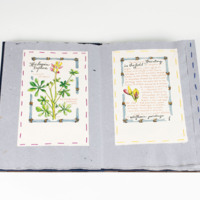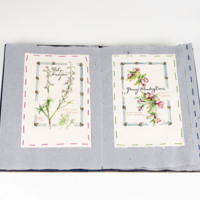A151. Hetch Hetchy Flora
A151. Peter and Donna Thomas. Hetch Hetchy Flora. Santa Cruz, California: Peter & Donna Thomas, 2013.
29 x 21 x 4 cm (11 ½” x 8 ¼” x 1 ½”), 20-page accordion, 30 copies.
Binding: Simple accordion; covers are blue Morocco leather over boards. Wooden lattice resembling a plant press on front and back covers. Title on multi-layered label on cover. Housed in a clamshell box covered in blue cloth. Title on decorated label inset on cover. Text and illustrations printed on smaller sheets of paper and stitched to accordion. Paper: Accordion is grey, handmade by Peter Thomas. Text and illustrations printed on cream, handmade by Peter Thomas. Printing: Digital. Typography: Reproduction of text handwritten by Donna Thomas. Illustration: Reproductions of nine watercolor paintings of wildflowers and one watercolor map by Donna Thomas.
“This book was conceived as a modern treatment of the historical ‘herbals’ we had admired and marveled at in antiquarian collections. Donna chose to paint wildflowers in Hetch Hetchy Valley because of the valley’s connection to John Muir, who as a botanist had influenced Donna’s interest in botanical painting. Around a hundred years before Donna made her watercolor paintings, John Muir had spent the last days of his life trying (and failing) to stop Hetch Hetchy Valley from being dammed and flooded. That failure inspired conservation movements worldwide, so his greatest failure led to his greatest success.
Early in the morning on May 22, 2013 Donna walked from the parking lot of the O’Shaughnessy Dam, following the trail around the reservoir to Wapama Falls. She studied the wildflowers, noting the varieties in bloom and the best specimens to paint. When the light was perfect for painting she walked the return trip, stopping to paint her chosen flowers. Finally she painted a landscape looking back from the dam over the area she had just painted in. At home, in the studio, Donna used her flora books to make positive identifications of the flowers she had painted. During the process she found out that just before the dam flooded the valley, Willis Jepson, California’s most distinguished early botanist, had collected and identified the flowers growing in Hetch Hetchy.
As Donna painted the borders on each of her original watercolors, as she wrote the text and drew the originals for the text pages, she thought about the Jepson connection. Just as Jepson had done, Donna collected the flowers she found, in one place, on one day. But instead of placing actual plant specimens between blotters, she had collected paintings of them. She began to think of her book as if it were Jepson’s plant press. This led us to bind the book as if it were a plant press like the ones used in Jepson’s day. Peter created paper for the project to both reference the strawboard blotters of a 19th century plant press and also emulate the look and texture of the granite walls of the Hetch Hetchy Valley. Sadly, and interestingly parallel to what had happened to Muir and Jepson, three months after Donna made her paintings there was a wildfire in Hetch Hetchy Valley, known as the Rim Fire, which scorched the area she had painted in, burning all the vegetation to the ground.”



